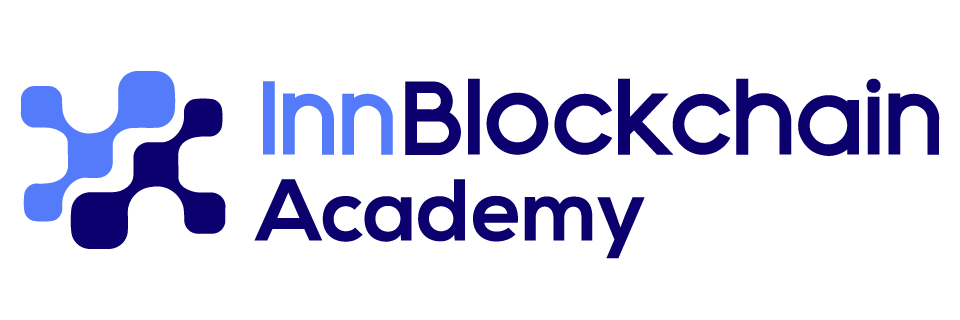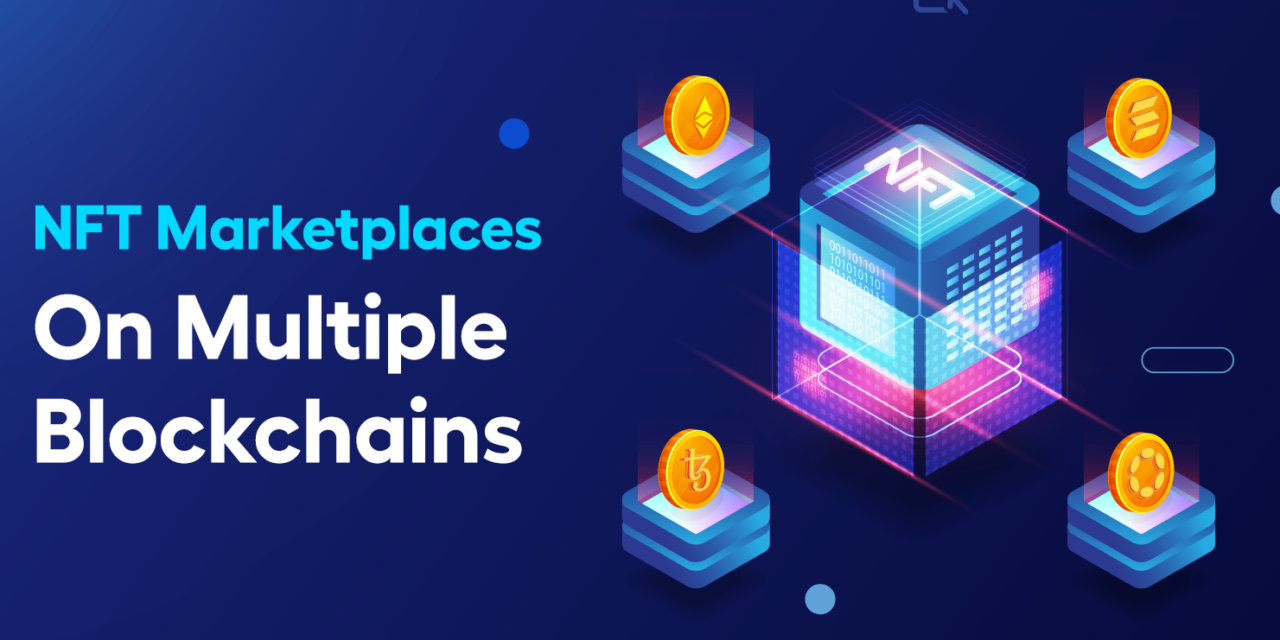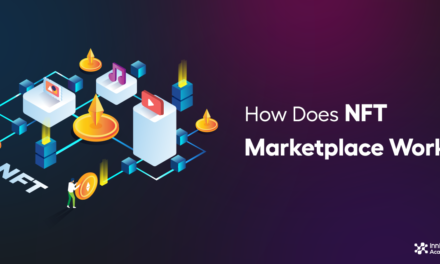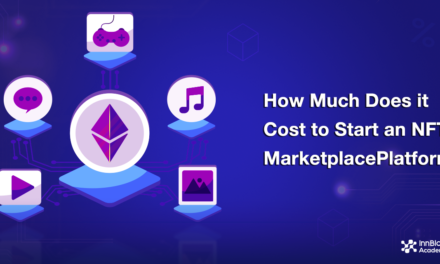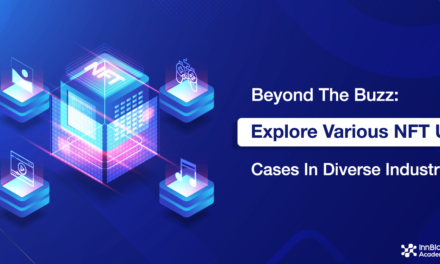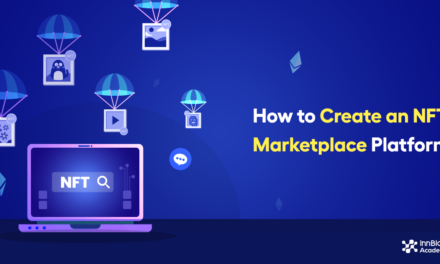The internet is whizzing with talk about the blockchain NFT marketplace, capturing the curiosity and attention of global cryptopreneurs. This transformative technology has taken the digital world by storm, reshaping how we perceive and trade digital assets.
The unusual surge in NFTs has moved the market cap beyond $40 billion, with projections showing a staggering growth trajectory toward $80 billion by 2027. But what is the key to the profitable growth of these assets? Why these assets are valuable for crypto lovers?
Can you guess?
This blog is going to discuss the various blockchain technologies, their role in NFT marketplace development, and the criteria to choose the best blockchain network for the success of the NFT marketplace business.
Blockchain Technology and its Role in NFT Marketplace
Blockchain plays a key role in the NFT marketplace development, offering various key functionalities. They are
- Blockchain provides transparent & immutable records of NFT ownership and authenticity
- It allows limited creation of NFTs, resulting in scarcity and uniqueness.
- It uses smart contracts which are pre-built conditions for automating royalty distributions, ownership transfer, and other marketplace functionalities.
- The data recorded on the blockchain can’t be tampered with or altered.
- Blockchain ensures the transfer of NFTs across various platforms, improving liquidity and expanding the user base.
- Blockchain’s decentralized nature improves security and makes it resistant to hacking and fraud.
- NFT marketplace leverages decentralized governance models, allowing community members to take part in the decision-making process.
These functionalities contribute to the development and success of the NFT marketplace, fostering trust, security, and innovation within the ecosystem.
Now let’s see about the uniqueness of the top-most blockchain network.
Overview of popular blockchain for NFT marketplace
Here let me list the top 11 most popular blockchain networks which best NFT marketplace.
Ethereum
Leading NFT marketplaces like OpenSea, Rarible, and DEcentraland, leverage the Ethereum network. Do you know why?
Founded in 2013, Ethereum is the famous blockchain network for dApps and Web3. With its trustworthy environment, smart contract functionality, and crypto coin Ether (ETH) ranks top in the market capitalization. Ethereum has the potential to support several use cases related to DeFi, NFT, cryptocurrency exchange, Wallet, and more.
Creating NFT on EVM is absolutely easy and simple. You can upload the file and fill in all the information. Settling ownership disputes is also simple, as metadata and transaction history are optimally identifiable. Tokens such as ERC721 and ERC1155 foster interoperability and simplify the development process. Act as a base network for crypto projects such as USDC and BAT. Moreover, Ethereum switched on its PoS mechanism in 2022 because it is less energy intensive, more secure, and best for executing new scaling solutions compared to previous PoW architecture.
Solana
Solana network, which includes cryptocurrency called SOL, one of the key players in the crypto market in the last few months. With a circulation of 346 million SOL, Solana’s market cap reaches $12.04 billion approximately.
Solana is an open-source network that has striking similarities to Ethereum but strives to work better than it. Solana uses a PoH consensus mechanism that provides timestamping transactions of SOL coins and digital assets like NFTs. This blockchain is created based on 3 concepts: scalability ( the network utilizes the PoH to scale to the rate of Moore’s law), low costs ( planned for an affordable price for all users ), and connectivity (establishing links between the projects).
Tezos
Tezos is another older network on the top blockchain list, though it was developed in 2014, still it maintains its value in 2023. It is an open-source blockchain network that supports smart contracts, and decentralized applications. The modification in the design has improved the performance and also increased the size limit for smart contracts on the Tezos network.
The updation in the design has enhanced the performance and also increased the size limit for smart contracts on the Tezos network. Tezos have new tools which automate the process of weaving NFTs into enterprise supply chains. Its unique features like the XDPoS mechanism, on-chain governance, and self-amendment protocol, distinguish Tezos from other blockchain networks.
dApps use Tezos to provide safety and code correctness for digital assets. Nowadays, the use cases of Tezos are racing around companies and marketplaces.
BSC
BSC is a blockchain network develop by the famous exchange Binance. It is design to provide a fast & low-cost alternative to the Ethereum network for dApps and digital asset transactions. BSC operates like a Binance chain, with BNB as its native currency. It uses PoSA which blend PoS and BFT mechanism to attain consensus and also to maintain the network’s security.
One of the features of BSC is its compatibility with the EVM, facilitating developers to port their existing Ethereum dApps to the BSC network with minimum effort. This compatibility results in increasing adoption and migration of projects from Ethereum to BSC, especially due to the least transaction fees and rapid confirmation time.
Cardano
Cardano is a decentralized blockchain platform that aims to provide secure and endurable infrastructure for the development of dApps and smart contracts. It differentiates from other blockchains by its protocols and layered architecture. It is design specially to address the limitations and challenges faced by other blockchain platforms by integrating engineering practices and academic principles.
One of Cardano’s special features is the PoS consensus mechanism which is referred to as Ouroboros. This mechanism guarantees the security & integrity of the network while being scalable and energy efficient. It also uses a layered protocol stack, splitting the settlement layer for transferring value from the computational layer for running smart contracts. This design facilitates better flexibility, security, and scalability of the platform.
Flow
Flow is a decentralized ledger that facilitates transparent and high performance, especially for NFT, dApps, and games. The thing that makes Flow network stand ahead is its scalability to interact with trillions of users at a time.
Flow uses the PoS consensus mechanism, especially because it can manage a high number of transactions with increased throughput. One of the famous NFT marketplace platforms built by Dapper Labs uses Flow blockchain, to facilitate its users with an enormous number of NFTs.
Flow is design to address usability and scalability challenges that occur while providing an ideal environment for creating decentralized applications and digital assets. Its programming language, unique architecture, and focus on NFTs have placed it as a promising platform within the blockchain ecosystem.
Each blockchain has unique characteristics. To know the comparison in short! Check Here………
TRON
Tron is a new entry to the blockchain community, launched in 2017. It is an open-source blockchain that has its own currency called TRX. Generally, crypto aspirants use this blockchain to create software solutions for media channels and entertainment.
Tron uses the PoS consensus mechanism to make them more credible for speedy transactions and the least gas fees. The USP of the Tron equally allocates the computing power to the holder of the native token. They use a decentralized virtual machine that facilitates the users to implement the programs via public nodes.
Through enhanced visibility, high performance, and increased scalability of assets, Tron is referred to as”Ethereum Killers”. This blockchain has the ability to handle billions of transactions simultaneously with no gas fees. The Uswap and APENFT is a famous NFT marketplace platform that uses the benefits of the Tron blockchain.
Polkadot
Polkadot is a multi-chain platform that facilitates different blockchains to interoperate and share information. It presents a unique approach to blockchain referred to as the “relay chain” or “parachain” model. These chains provide flexibility and specialization.
Polkadot’s architecture is based on Substrate, a blockchain development framework that facilitates the developers with a modular and customizable framework to develop their own blockchains. It presents a novel governance mechanism that allows all the token holders to take part in the decision-making process of the network.
With “DOT staking”, token holders can lock their tokens to contribute to the network’s security and take part in on-chain governance by voting on network upgrades or changes.
Fantom
Fantom is a blockchain network designed to offer secure, fast, and scalable solutions for dApps and smart contracts. It uses a DAG consensus mechanism called “Lachesis Protocol” to attain high throughput and the least transaction fees.
Fantom was designed with the intention to overcome the scalability limitations addressed by other blockchain networks by implementing a DAG-based structure called “Fantom Opera Chain”. Furthermore, Fantom incorporates a decentralized governance model, where token holders can take part in decision-making related to network updates, community initiatives, and parameter changes. This model provides a decentralized transparent development process.
Fatom has gained the attention of cryptopreneurs with its scalability and high-performance dApps. It has the potential to manage a large number of transactions with low fees. Moreover, Ethereum compatibility makes it an attractive option for developers pursuing a blockchain platform that handles complex and resource-intensive applications.
ImmutableX
ImmutableX is a layer 2 scaling solution for Ethereum designed with the intention to address high transaction fees and scalability associated with the Ethereum network. It is built on the top of the Ethereum blockchain and uses a technology called “zk-rollups” to attain prominent enhancement in transaction throughput and cost efficiency.
One of the key advantages of ImmutableX is that it provides near-instant transaction confirmation times and the lowest transaction fees. This scalability enhancement makes it more practical for developers and users to engage with the network without experiencing high costs or delays.
Recently, ImmutableX has gained attention as an efficient and scalable solution for the NFT marketplace, attracting more projects and partnerships with the Ethereum ecosystem. Notable projects “God Unchained” a famous blockchain-based card game, have moved to ImmutableX to leverage its scalability and cost benefits.
Zora
Zora network aims to mint cheaper, faster, and more enjoyable with a focus on scalability and gas efficiency compared to other blockchain platforms. Most of the famous brands prefer to use Zora to mint NFT, as it has established its own layer 2 blockchain network to reduce costs and support creativity.
The Zora network is built on open-source Optimism’s tech stack, maintained by Optimism Collective. The platform was integrated with Zora’s existing tools and is already supported by more than 35 web3 entities such as PleaseDAO, sound.xyz, Rainbow Wallet, and more.
Zora is a unique platform, designed, built, and deployed by a team of NFT experts. For your reference, NFT artist Latasha has been the head of the community in Zora development since June 2021.
Criteria for selecting the unique blockchain NFT marketplace platform
If you are in search of a blockchain network for the development of the NFT marketplace, then you have to consider a few parameters. This section highlights those parameters which give you a better understanding.
Transaction and Token Development Cost
An NFT-based transaction requires cost-effective solutions as they won’t involve million-dollar trading. Instead, they often go for micro-transactions involving digital collectibles, in-game digital assets, card games, and more. In this case, traders won’t show interest to pay high fees for transactions.
So cost minimization is important for adoption and usability. This leads to the need for optimized blockchain development costs, particularly for the NFT marketplace. Hence, blockchain’s fees for NFT transaction is the most important for consideration, the best one is being feeless.
Robust Smart Contracts
The strength of its smart contract is the key contribution to the overall security that the blockchain network provides. Writing secure and bug-free code is most necessary for this case. Smart contracts have to undergo rigorous testing, ensuring the highest degree of resilience and efficiency. This makes developers and users of the NFT marketplace free from hacks, breaches, and downtime.
Possibility of Forking
NFTs are valuable assets due to their uniqueness and rarity. Hard forks could pose various threats to these aspects, as duplicating NFTs puts their scarcity into question. Asset ownership is staked here, where NFTs on the old chain might lose their value. So it is necessary to develop NFT marketplaces on fork-proof blockchains.
Speed of Transaction
Speed is one of the key factors for a successful digital system, especially for the system involved in the storage and transfer of value. But speed must not affect the cost and security of the system, which happens in most of the blockchains. Blockchain achieving faster finality is ideal for the NFT marketplace development.
Security
Blockchain might be vulnerable to numerous attacks. Platforms with PoW consensus mechanisms are sensitive to attacks where attackers gain control over the network’s computational power. Loss of money, access, and data are the unavoidable outputs of such kinds of attacks; decentralization is compromised. Hence, for NFT marketplace development, it is better to go for a blockchain with mining mining-free consensus mechanism like PoS.
I hope now you might get an idea to choose the right blockchain network for your platform. If you want to know more about the steps to start an NFT marketplace business then check out – How To Start an NFT Marketplace Business? – A Guide For 2023
Conclusion
The above comparison is done depending on a few fundamental parameters that would help you to analyze and choose one of the best blockchain platforms according to your requirements.
This article depicts some of the top-most blockchain networks that are highly preferred for NFT marketplace development.
If you plan to develop an NFT marketplace, then it’s upto to you to choose the ideal blockchain for your platform, as it seals the business. Consider researching your niche which is one of the key factors to develop your platform. On the other side, you can also get guidance from blockchain experts like InnBlockchain best NFT marketplace development company to have a better picture!
